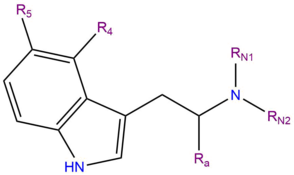MPT: Difference between revisions
>Unity No edit summary |
>Unity No edit summary |
||
| Line 1: | Line 1: | ||
{{approval}} | |||
{{proofread}} | {{proofread}} | ||
{{SubstanceBox/MPT}} | {{SubstanceBox/MPT}} | ||
| Line 6: | Line 8: | ||
| ''[[MPT/Summary|Summary sheet: MPT]]'' | | ''[[MPT/Summary|Summary sheet: MPT]]'' | ||
|} | |} | ||
''' | '''MPT''' (also known as '''N-Methyl-N-propyltryptamine''' and '''Methylpropyltryptamine''') is a synthetic [[psychedelic]] of the [[tryptamine]] class. It is extremely uncommon and has little history of human usage. | ||
==Chemistry== | ==Chemistry== | ||
| Line 93: | Line 95: | ||
==See also== | ==See also== | ||
*[[Responsible use]] | *[[Responsible use]] | ||
*[[Research chemical]] | |||
*[[Psychedelics]] | *[[Psychedelics]] | ||
*[[ | *[[Tryptamine]] | ||
==References== | ==References== | ||
<references/> | <references/> | ||
Revision as of 19:51, 19 December 2016
This page has not been fully approved by the PsychonautWiki administrators. It may contain incorrect information, particularly with respect to dosage, duration, subjective effects, toxicity and other risks. It may also not meet PW style and grammar standards. |
| MPT | |||||||||||||||
|---|---|---|---|---|---|---|---|---|---|---|---|---|---|---|---|
 |
|||||||||||||||
| Chemical Nomenclature | |||||||||||||||
| Common names | MPT, Methylpropyltryptamine | ||||||||||||||
| Substitutive name | N-Methyl-N-propyltryptamine | ||||||||||||||
| Systematic name | N,N-diethyl-2-(1H-indol-3-yl)ethanamine | ||||||||||||||
| Class Membership | |||||||||||||||
| Psychoactive class | Psychedelic | ||||||||||||||
| Chemical class | Tryptamine | ||||||||||||||
| Routes of Administration | |||||||||||||||
|
|||||||||||||||
| Interactions | |||||||||||||||
| Summary sheet: MPT |
MPT (also known as N-Methyl-N-propyltryptamine and Methylpropyltryptamine) is a synthetic psychedelic of the tryptamine class. It is extremely uncommon and has little history of human usage.
Chemistry

 |
This chemistry section is incomplete. You can help by adding to it. |
Pharmacology
Due to the lack of research regarding the substance, all discussion regarding the pharmacology of it is purely based on its structure and subjective effect similarities to other tryptamine psychedelics such as psilocin and DMT. With this in mind, MPT is thought to act as an 5-HT2A partial agonist.
However, the role of these interactions and how they result in the psychedelic experience continues to remain elusive.
Subjective effects
 |
This subjective effects section is a stub. As such, it is still in progress and may contain incomplete or wrong information. You can help by expanding or correcting it. |
Disclaimer: The effects listed below cite the Subjective Effect Index (SEI), an open research literature based on anecdotal user reports and the personal analyses of PsychonautWiki contributors. As a result, they should be viewed with a healthy degree of skepticism.
It is also worth noting that these effects will not necessarily occur in a predictable or reliable manner, although higher doses are more liable to induce the full spectrum of effects. Likewise, adverse effects become increasingly likely with higher doses and may include addiction, severe injury, or death ☠.
Physical effects
Cognitive effects
- Conceptual thinking
- Cognitive euphoria
- Delusions
- Emotion enhancement
- Immersion enhancement
- Increased music appreciation
- Memory suppression
- Novelty enhancement
- Personal bias suppression
- Thought loops
- Time distortion
- Unity and interconnectedness
Visual effects
Enhancements
Distortions
- Drifting (melting, breathing, morphing and flowing)
- Colour shifting
- Depth perception distortions
- Perspective distortions
- Symmetrical texture repetition
- Tracers
- After images
- Brightness alteration
- Diffraction
Hallucinatory states
- Transformations
- Internal hallucinations (autonomous entities; settings, sceneries, and landscapes; alterations in perspective and scenarios and plots)
Auditory effects
Toxicity and harm potential
The toxicity and long-term health effects of recreational MPT use do not appear to have been studied in any scientific context and the exact toxic dose is unknown. This is because MPT is a research chemical with very little history of human use. Anecdotal evidence from people within the psychonaut community who have tried MPT suggests that there are no negative health effects attributed to simply trying the drug by itself at low to moderate doses and using it very sparingly (but nothing can be completely guaranteed). Independent research should always be done to ensure that a combination of two or more substances is safe before consumption.
It is strongly recommended that one uses harm reduction practices when using this drug.
Tolerance and addiction potential
MPT is not habit-forming and the desire to use it can actually decrease with use. It is most often self-regulating.
Tolerance to the effects of MPT is built almost immediately after ingestion. After that, it takes about 3 days for the tolerance to be reduced to half and 7 days to be back at baseline (in the absence of further consumption). MPT presents cross-tolerance with [[Cross-tolerance::all psychedelics]], meaning that after the consumption of MPT all psychedelics will have a reduced effect.
Dangerous interactions
Although many drugs are safe on their own, they can become dangerous and even life-threatening when combined with other substances. The list below contains some common potentially dangerous combinations, but may not include all of them. Certain combinations may be harmless in low doses of each but still increase the potential risk of death. Independent research should always be done to ensure that a combination of two or more substances is safe before consumption.
- Tramadol - Tramadol lowers seizure threshold[1] and psychedelics may cause occasional seizures.
- Stimulants - Stimulants may provoke anxiety or thought loops.
Legal issues
 |
This legality section is a stub. As such, it may contain incomplete or wrong information. You can help by expanding it. |
- United Kingdom - It is illegal to produce, supply, or import this drug under the Psychoactive Substance Act, which came into effect on May 26th, 2016.[2]
See also
References
- ↑ Dose-independent occurrence of seizure with tramadol - Springer | http://link.springer.com/article/10.1007/BF03161089#/page-2
- ↑ Psychoactive Substances Act 2016 (Legislation.gov.uk) | http://www.legislation.gov.uk/ukpga/2016/2/contents/enacted